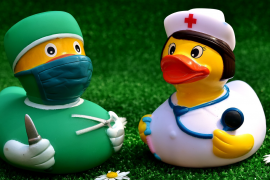While working with a prominent south Florida Plastic Surgeon a few years ago, I received a phone call from the father of a potential patient. I will admit, I totally judged the call from the beginning – I remember thinking “You are 27 years old – why is your Dad calling the doctor for you?”.
And then the story unfolded (I then remember thinking – Alexia, you are such a bitch).
His son was a well known personal trainer and fitness enthusiast out of state. He had worked extremely hard to master his craft, grow his business and clientele and was living life to the fullest.
Then one day his girlfriend, who was also a medical professional, noticed the back of his leg was a little bit pink. When she mentioned it to him, he said it was tender and that he likely pulled a hamstring in the gym. As soon as 24 hours later he developed a fever, chills and extreme pain down his entire leg. She encouraged him to go to the hospital. He waited one more day to see if maybe it was just his hamstring and nothing more.
When he arrived at the emergency room and explained his situation, they ran some bloodwork and discovered he had developed Necrotizing Fasciitis – a serious bacterial infection that eats away at the tissue below the skin. Also known as flesh-eating infection, Necrotizing Fasciitis can often be corrected with intravenous antibiotics if diagnosed at early onset. If you delay care, you may require surgery or, at worst, experience fatal sepsis – a deadly blood infection. This patient was somewhere in the middle.
Upon arrival to the emergency room, they discovered it had spread and the only way to stop further necrosis was surgical removal of tissue. A professional athlete and entrepreneur in his twenties walked away from the hospital having had 27 pounds of tissue removed from his ankle to his glutes.
What went wrong?
Commonly disguising itself as a pulled muscle or strain, Necrotizing Fasciitis often attacks one with an already weakened immune system. It will kill one in four and can do so within 12-24 hours in extreme cases. It is rarely spread person-to-person – unless there is direct contact with infected tissue – but can be picked up quite easily by someone with a cut, scrape or wound in any environment where bacteria is present.
Two lessons here:
First lesson:
How can you prevent this from happening to you?
There is about a 99.9% chance this happened at his gym. The gym is one of my favorite places on earth. Literally. It’s an hour a day I think of nothing else and a welcome change from four inch heels and lipgloss. A gym is a sanctuary. A pretty disgusting sanctuary. Sweat, spit, bare feet…every slimey, gross thing you can imagine. Throw in a little heat and it’s quite literally a breeding ground for funk. How can we continue to love the gym and not freak about the funk?
- Make sure your gym is clean. Are disinfectant sprays or wipes available and accessible? Are the weight benches clean and undamaged? Damaged surfaces are porous and can hold bacteria easily.
- Ensure the bathrooms are stocked with antibacterial soap and antibacterial hand sanitizer. And use them before and after every workout.
- Do NOT go barefoot in any common areas. If you’re in a martial arts gym, as I am, the mats are okay. Not off the mats. And hold your gym accountable for ensuring that as well.
- Back to the MMA gyms – are the mats cleaned after every class? They should be.
- Wipe down equipment BEFORE, as well as after, use. I have ripped my hands opens doing pull-ups, stopped to clean the bar and had my coach tell me I can clean it after I finished my workout. Um, no thanks. It’s not my blood I’m worried about. It’s whatever was on that bar before I got to it.
- Bring your own exercise mats. Yoga mats and ab mats. Invest in one.
- Avoid the communal hot tubs at the gym. Who knows how often they are treated and who actually showers beforehand as required.
- Wash your hands, arms and face immediately upon finishing your training.
- Shower immediately upon getting home with antibacterial soap.
- Wash your gym clothes in hot water after wearing.
- Invest in some antibacterial ointment and bandages. Cover up any scrapes or scratches prior to going to the gym.
- Familiarize yourself with the signs of common skin infections and don’t take them lightly. Know what to look for and use common sense.
Second lesson?
Plastic surgery is not solely cosmetic. It can be not only life-changing but life-saving. While I hope you never encounter a scenario such as this, if you do, be sure to seek out a seasoned and board-certified plastic surgeon.
Here’s to practicing “safe gym”.







